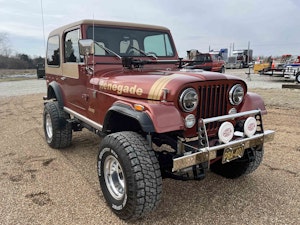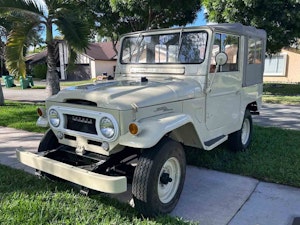Media | Articles
Rudi Klein “Junkyard” Auction Brings a Lot of Treasure
It’s tough to explain to a non-car person, but barn finds are exciting. Discovering them is thrilling, and valuing them is interesting. By “barn find” I mean the neglected, sometimes decrepit cars that emerge from decades of storage in a barn (or garage, warehouse, etc.) like some undiscovered artifact or long-lost work of art. Sometimes the cars are rare and worth millions. Sometimes there’s a whole group of barn find cars uncovered. When such collections get consigned to auction—be they from the French countryside, warehouses in northern Italy, or Nebraskan corn fields—they always generate buzz.
Perhaps none have gotten as much attention as the Rudi Klein “Junkyard” collection auction held this past Saturday in Los Angeles. Over 500 lots of parts and vehicles sold for a total of $29.6M dollars, with several records set and many estimates smashed. RM Sotheby’s reported bidders from 39 countries and 36 U.S. states. This may have been a “junk” auction, but you know what they say about one man’s trash and another’s treasure.
Rudi Klein was a German who moved to the U.S. in the 1950s. Eventually, he started a business called Porsche Foreign Auto Wrecking and set up a junkyard in Los Angeles. Porsche may have been his specialty, but he built up a treasure trove of parts for all sorts of foreign cars. It wasn’t just parts, though, as he accumulated complete (and almost complete) automobiles, some of them extremely valuable. He was reportedly notorious for almost never letting anyone in to see this automotive treasure trove, although he sold off some of the cars later in life before passing in 2001. The salvage yard then remained mostly untouched until being cataloged for auction.
Many of the lots at this sale were parts, loosely organized by make/model; Porsche 356 suspension bits over here, a pile of Mercedes-Benz grilles over there. There were engines—many of them Porsche, Mercedes, or Rolls-Royce/Bentley—some offered in a package of four or five. There were wheels, of both the rolling and steering variety. There were seats, headlights, exhausts, brake drums, etc.




Then there were the cars, and what could best be described as former cars. Many were wrecks far beyond saving, and best used for parts or garage art. Others were on the border of parts car and salvageable restoration project. Some were in decent shape. There was a literal wall of Porsches.
Marketplace
Buy and sell classics with confidence
Many of the automotive lots brought strong prices, including a handful of truly special and even a few one-off cars. Here are the highlights:
1968 Lamborghini Miura P400

The Rudi Klein collection auction had three Lamborghini Miuras in different states of disrepair, plus another front-third of a Miura strapped to the back of a rusty VW Type 2 pickup (that whole package sold for $56K). A bent-up P400 S with missing body panels sold for $967,500 and an early thin-chassis P400 missing its engine sold for $610,000, but the cleanest and most expensive Miura was this $1.325M 1968 P400, almost double its high estimate. The 159th of 275 built, the car was originally finished in yellow (the Italians call it Giallo) and had been at the Los Angeles salvage yard for nearly 50 years before the auction.
1964 Iso Grifo A3/L Spider Prototype

There were quite a few cars in the 1950s and 1960s to combine European sophistication and style with reliable high-performance American V-8s, but the Iso Grifo is one of the prettiest, and best. Only one Iso Grifo—this one—left the factory as a convertible. Klein bought it from TV producer Greg Garrison in 1980 and few people have seen it since. Unique features to the prototype include special side exhaust and rear fender vents, and it sold for $1.875M, making it the second most expensive Grifo ever sold at auction.
1971 NSU ro80 2 Porte + 2 by Pininfarina

Delightfully weird and intriguing, this is a one-off show car displayed by Pininfarina at the 1971 Turin and 1972 Brussels Motor Shows. Underneath the four-door bodywork is an NSU ro80, the revolutionary but ill-fated rotary-powered executive car. It entered the junkyard in 1995 as one of the last cars Klein bought and appears mostly complete and relatively clean. It sold for $461,500.
1939 Horch 855 Special Roadster by Gläser

This car is reportedly the only surviving example of Horch’s ultimate model, the 855. An eight-cylinder car designed for the then-new autobahn, the 855 was based on a shortened version of Horch’s 853 model. One of the five to seven cars originally built, this one sold to a U.S. counterintelligence officer serving in Germany in the later 1940s, and eventually appeared with Rock Hudson in the 1959 film The World Is Ours. Klein bought it in 1980, and in 1992 it went on display at the Audi Forum museum in Germany (August Horch founded Audi), and was restored there. It’s therefore in far better shape than the other cars in the collection and isn’t really a barn find at all, though its appearance at this auction was a unique buying opportunity. It sold for $3,305,000.
1935 Mercedes-Benz 500 K ‘Caracciola’ Special Coupe by Sindelfingen

Built for Mercedes-Benz’s star Grand Prix driver, Rudi Caracciola, who won three championships driving the Silver Arrows, this 500 K is a one-off with special bodywork. Caracciola reportedly used it until the late 1930s, and at some point, it wound up in Ethiopia hidden under tarps and manure. Klein bought it in 1980, and it hasn’t been seen in public since. It sold for $4.13M.
1956 Mercedes-Benz 300 SL Alloy Gullwing

Any 300SL is a special, valuable car. Mercedes-Benz built over 3000 of all types so they aren’t the rarest thing in the world, but there were a precious few 29 examples fitted with light alloy bodywork, a higher-spec “NSL” engine, sports suspension, 4.11:1 rear axle, Rudge centerlock wheels, and Plexiglas rear and side windows. These cars are highly prized by collectors.
The star of the Rudi Klein collection was the 26th of those 29 cars. Luigi Chinetti ordered it new in black over red leather with a windshield washer system and 3.42:1 axle. Klein bought it from Chinetti in 1976 for 30 grand. At some point before that it got repainted silver, and in Klein’s ownership bits like the front bumpers, shift knob, jack and tool kit, and spare wheel were sold off. Its $9.355M final price at this auction is, remarkably, the most any of these cars has ever sold for at auction, well over its $6M high estimate and the $8.2M value for a condition #1 (“concours”) example in our price guide. Two perfectly good, restored Alloy Gullwings have also sold at auction in recent years for significantly less. One sold for $5.01M and another for $6.825M, both in 2022.






















After looking through the auction listing and noting the condition and prices of the engines, body panels and poor condition mostly complete cars, it’s clear there are many willing to “invest” much money and time in restoring classic autos. Very interesting collection of older European classics. The nice complete cars that brought high prices will likely be better investments than the lesser condition cars and parts. Thanks for the article.
He had excellent taste!
I was working in the car business in LA in the 70,s my boss sent me to Porche foreign to pick up a part,which meant he was the only one who had one. He intentionally left the “s” out of Porsche to avoid lawsuits but everyone knew what it meant. The 930,s were brand new then and they had a turbo engine sitting on the floor in the waiting room. Rudy was a legend in the industry even back then although very frustrating to do business with.
Rudi passed away in 2001. How did a collection/junkyard sit for 23 years before being sold off? Were there no heirs waiting for their share?
I’m intrigued by all but the NSU. The cabin looks like a later Oldsmobile I remember. The front fenders say early Falcon.
A guy I knew at had one of these Gullwings. On occasion his wife would drive him to work in it so that he could “show it off” and then drive it right back home. I wasn’t particularly interested in it. I thought it looked sort of clumsy, but I was fascinated by the doors.